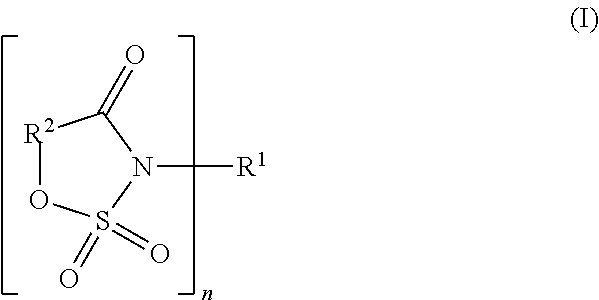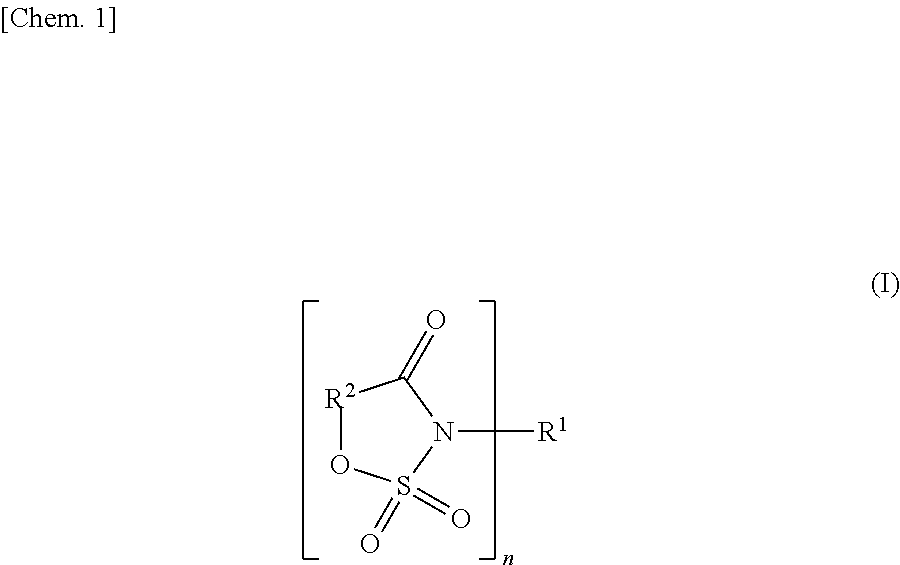Nonaqueous electrolyte solution for secondary battery and nonaqueous electrolyte secondary battery
a secondary battery and nonaqueous electrolyte technology, applied in the direction of batteries, non-aqueous electrolyte cells, cell components, etc., can solve the problems of battery resistance at a low temperature not higher than, and the properties of a film formed in the electrode are not sufficient to ensure the battery characteristics in the wide temperature region, so as to improve the charge-discharge characteristics of a nonaqueous electrolyte secondary battery, improve the thermal stability of a non
- Summary
- Abstract
- Description
- Claims
- Application Information
AI Technical Summary
Benefits of technology
Problems solved by technology
Method used
Image
Examples
example 1
Preparation of Electrolyte Solution
[0094]LiPF6 was used as an electrolyte. A solvent composed of a mixture containing 30% by volume of ethylene carbonate and 70% by volume of methyl ethyl carbonate was used. In this solvent, LiPF6 was dissolved so that the concentration might become 1.0 mol / l, and as an additive for forming an ion-conductive film on an electrode, a cyclic amide compound composed of an N-acylsulfonic ester was added. In Example 1-1, 3,6-dimethyl-3,4-dihydro-1,2,3-oxathiazin-4-one 2,2-dioxide was added,
[0095]in Example 1-2, 6-methyl-3,4-dihydro-1,2,3-oxathiazin-4-one 2,2-dioxide lithium was added,
[0096]in Example 1-3, 3-fluoro-6-methyl-3,4-dihydro-1,2,3-oxathiazin-4-one 2,2-dioxide was added,
[0097]in Example 1-4, 5-fluoro-3-methyl-1,2,3-oxathiazin-4-one 2,2-dioxide lithium was added, and
[0098]in Example 1-5, 6-methyl-3,4-dihydro-1,2,3-oxathiazin-4-one 2,2-dioxide was added, in each amount of 1.0% by weight based on 100% by weight of the total of the solvent. Thus, ele...
examples 2-1 to 2-8
[0116]In Examples 2-1 to 2-8, batteries were prepared by the same method as in Example 1-1. The content of 3,6-dimethyl-3,4-dihydro-1,2,3-oxathiazin-4-one 2,2-dioxide was changed as shown in Table 2.
TABLE 2Electrolyte saltAdditiveConcen-Amount added0° C. reaction85° C.tration[part(s) byresistanceexpansionSolventType[mol / L]Typemass]value [mΩ]ratio [%]Ex. 2-1EC / EMCLiPF613,6-dimethyl-3,4-dihydro-1,2,3-0.02192218oxathiazin-4-one 2,2-dioxideEx. 2-23,6-dimethyl-3,4-dihydro-1,2,3-0.05163180oxathiazin-4-one 2,2-dioxideEx. 2-33,6-dimethyl-3,4-dihydro-1,2,3-0.2159166oxathiazin-4-one 2,2-dioxideEx. 2-43,6-dimethyl-3,4-dihydro-1,2,3-0.5144145oxathiazin-4-one 2,2-dioxideEx. 2-53,6-dimethyl-3,4-dihydro-1,2,3-2156130oxathiazin-4-one 2,2-dioxideEx. 2-63,6-dimethyl-3,4-dihydro-1,2,3-5166129oxathiazin-4-one 2,2-dioxideEx. 2-73,6-dimethyl-3,4-dihydro-1,2,3-10193124oxathiazin-4-one 2,2-dioxideEx. 2-83,6-dimethyl-3,4-dihydro-1,2,3-15260122oxathiazin-4-one 2,2-dioxideComp.EC / EMCLiPF61none201233Ex. 1-1EC:...
examples 3-1 to 3-3
[0118]Batteries were prepared by the same method as in Example 1-1, except that the constitution of the electrolyte solution contained type 1 additives in table 3 instead of 3,6-dimethyl-3,4-dihydro-1,2,3-oxathiazin-4-one 2,2-dioxide and further contained 0.5 part by mass of 2-acryloyloxyethyl isocyanate in Example 3-1, 1,1-bis(acryloyloxymethyl)ethyl isocyanate in Example 3-2 and 2-methacryloyloxyethyl isocyanate in Example 3-3, respectively. The results of measurements of reaction resistance at a low temperature and high-temperature characteristics are set forth in Table 3.
PUM
 Login to View More
Login to View More Abstract
Description
Claims
Application Information
 Login to View More
Login to View More - R&D
- Intellectual Property
- Life Sciences
- Materials
- Tech Scout
- Unparalleled Data Quality
- Higher Quality Content
- 60% Fewer Hallucinations
Browse by: Latest US Patents, China's latest patents, Technical Efficacy Thesaurus, Application Domain, Technology Topic, Popular Technical Reports.
© 2025 PatSnap. All rights reserved.Legal|Privacy policy|Modern Slavery Act Transparency Statement|Sitemap|About US| Contact US: help@patsnap.com



